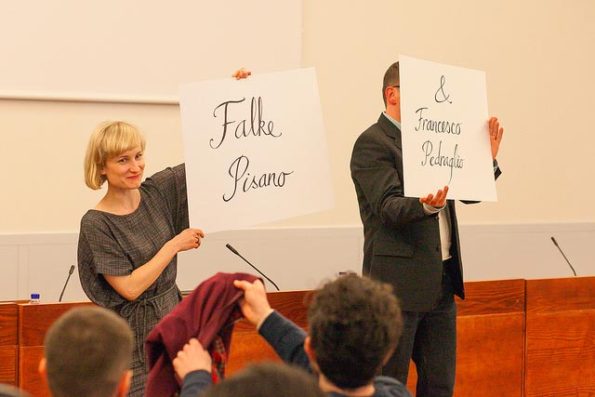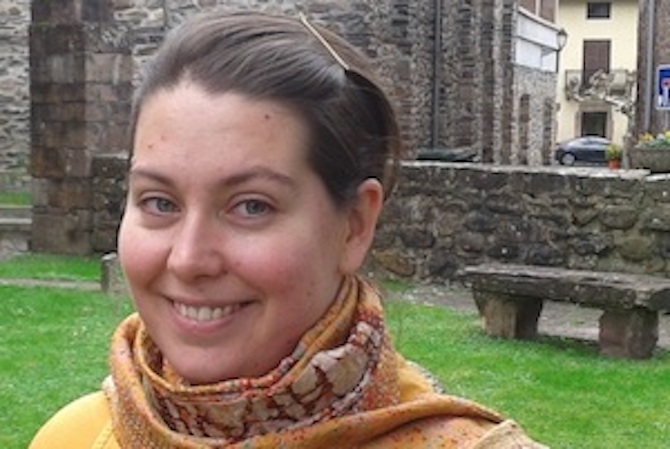Search
To search for an exact match, type the word or phrase you want in quotation marks.
A*DESK has been offering since 2002 contents about criticism and contemporary art. A*DESK has become consolidated thanks to all those who have believed in the project, all those who have followed us, debating, participating and collaborating. Many people have collaborated with A*DESK, and continue to do so. Their efforts, knowledge and belief in the project are what make it grow internationally. At A*DESK we have also generated work for over one hundred professionals in culture, from small collaborations with reviews and classes, to more prolonged and intense collaborations.
At A*DESK we believe in the need for free and universal access to culture and knowledge. We want to carry on being independent, remaining open to more ideas and opinions. If you believe in A*DESK, we need your backing to be able to continue. You can now participate in the project by supporting it. You can choose how much you want to contribute to the project.
You can decide how much you want to bring to the project.

The European Network of Public Art Producers, ENPAP, presented in Bilbao its first public programme, under the title “Going public, telling it as it is?”. A narrative title, with a series of implications that reveal the lines of work, the doubts and the challenges faced by the producers of public art in a Europe that is seeing the commons reduced at an alarming rate.
At a time when institutions are seeing their services threatened by privatisation; when culture and art are going through their worst moments of institutional support; when the definition of the public is ever more complex and placed in doubt, ENPAP’s energy is like a breath of fresh air. However, to say that ENPAP is publicly presenting itself at the most opportune socio-political moment would be to underestimate the work that has been carried out over the last two years. When the workers, of Mossutställningar (Stockholm, Sweden), Baltic Art Centre (Visby, Sweden), consonni (Bilbao), Situations (Bristol, United Kindom), Vector (Iasi, Romania) and SKOR (Ámsterdam, Holland), the members of the network, started, they quite probably had already foreseen what was heading our way, in part because they detected the victory of neo-capitalism and in part given their wealth of experience in public and contextual projects, a characteristic that makes them without a doubt more sensitive to a perception of the common ground.
Since then, these six organisations that identify with (and are proud of) their dedication to the public have joined forces, in a process of self-analysis, to seek common solutions to specific problems. All behind closed doors, albeit with sporadic complicities, by way of the case studies from each of the contexts, probably with places of encounter and dissonance.
The desire to make their conclusions reach us (the questions for which remain unresolved) has materialised into a series of actions carried out in Bilbao, under the title “Going public, telling it as it is?”. A suggestive introduction and perfectly chosen, as in the first place it shows the need to publish a working process, and without precipitating anything, the simple question mark suggests that we are likely to find more questions than answers. This need to place our cards on the table derives, obviously, from the public nature of the participating organisations, but it probably wouldn’t be far off the mark to interpret a double meaning in the word “public”, understanding it as the vindication of its current pertinence and to share this reflection, as if dealing with a shared responsibility towards the processes of knowledge.
The question “telling it as it is?”, with its appropriate questioning tone, submerges us fully in the basic questions that arose during the three days of public interventions (by Martha Rossler, Itziar Barrio, Phil Collins, Alex Reynolds and María Ruido during the day, Jeleton, OJO, Institut Fatima and Begoña & la Jawara at night), performative talks (with Asier Mendizábal, Falke Pisano & Francesco Pedraglio, Olof Olsson, Goldin + Senneby, Patricia Esquivias and Asli Cavusoglu) and working sessions with different institutions and specially invited experts. On various occasions the question of what or who really represented the public were touched upon, such as in the performance of Cavusoglu, with The Hand of God Church, which left in evidence the exclusive presence of white people, with probably more or less atheist and left wing political leanings and dedicated professionally to the world of art, in a symposium about the public and the shared. Olof Olsson ironized very seriously about the meaning of Europe, a subject of growing complexity for the members of the network. Language also ended up being simultaneously a source of confusion and clarification, given that in the performative lectures all the participants opted for English, even though translation was provided and some of them were Spanish speakers, making it clear that the international presence won the symbolical combat over the local.
During the last working session, behind closed doors, the question was opened up to the projection of a new phase: the ENPAP shared their ideas and doubts with colleagues and offered to continue the project with the participation of more members, more precise lines and common actions. One day resulted too short to place on the table all the questions that had arisen during the previous days, and placed in evidence the possible differences in approach of the organisations: while one working group pointed to the need to seek solutions to shared problems, another stressed the need to establish a series of basic definitions regarding the public, the common and the context, amongst others, to be able to recognise the common ground and differentiating elements among the different organisations and to use these obvious differences as a starting point.
And here we reach the key point, as it seems clear that within ENPAP itself there exist many differences. How to compare an agency such as SKOR, a large scale institution with a budget to match, with an organisation like consonni, that has to struggle for each project and each penny of sponsorship? What are the points of union between the context of Stockholm, Sweden and that of Iasi, Rumania? And getting to the crux of the question, is public understood in the same way in Bristol as it is in Bilbao? When it comes down to it, what are we talking about when we talk about the public? A space in the city? The terrace of a museum? A few specific institutions? Shared values?
The ENPAP’s contribution is a large step forward with regard to these questions: it places them on the table, recognises them as a value and not a limitation, and throws itself into an analysis of them, without aiming for definitive resolutions, but with the firm intention of finding a common ground from where to approach the contextual and specificity of each situation. If the steps in this sense ultimately lead to its future amplification, its contribution will have been, without a doubt, invaluable.

For Haizea Barcenilla art doesn´t seem to exist on its own, but as being interlinked with various social systems, embedded between ideologies and forms of looking, included in exchange networks of, buying and selling, production and exhibition. When she writes criticism, she likes to extend her object of study as much as possible, understanding it through being part of it, considering what her position is. For her, it is impossible to see art without everything else, and everything else without art. And sometimes she manages to interweave the two sides.
"A desk is a dangerous place from which to watch the world" (John Le Carré)